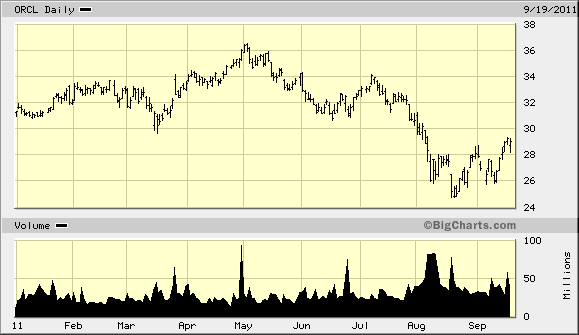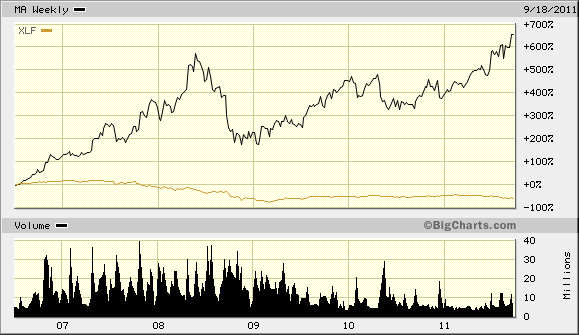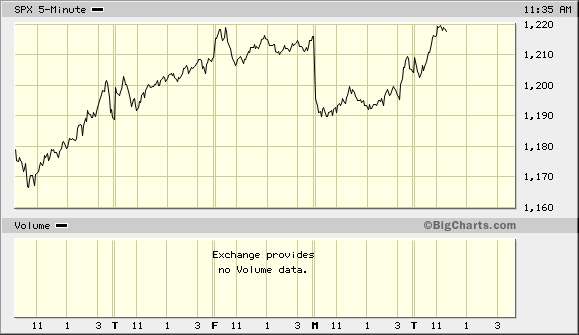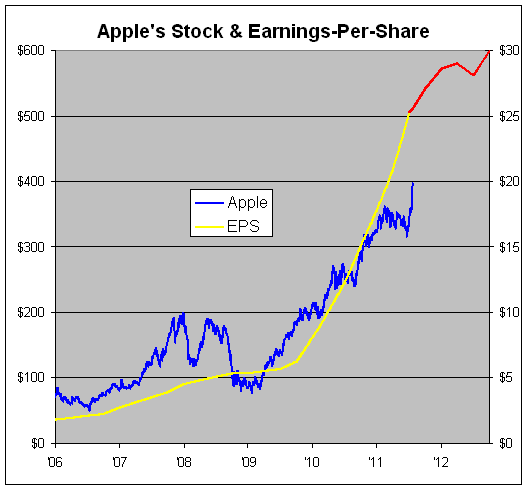Archive for September, 2011
-
Brent Thill on Oracle
Eddy Elfenbein, September 20th, 2011 at 7:55 pmHere’s a good discussion on Oracle‘s ($ORCL) earnings report. The stock is up to $29.29 after hours.
-
Oracle Earns 48 Cents Per Share
Eddy Elfenbein, September 20th, 2011 at 4:06 pmOracle ($ORCL) just reported its fiscal Q1 earnings of 48 cents per share. In my eyes, this was a disappointment. I was expecting earnings of at least 51 cents per share. The Street’s consensus was for 46 cents per share.
The next event will be the company’s earnings call which will contain the forecast for the current quarter. Three months ago, Oracle told us to expect earnings to range between 45 cents and 48 cents per share.
Revenue rose to $8.4 billion which was ahead of the Street’s forecast of $8.35 billion. In the past 12 months, Oracle’s cash flow is up 46%.
While Oracle fell short of my very optimistic forecast, the company still delivered solid results. In the after-hours market, the stock is slightly above today’s close (although the stock dropped 2.3% during the day).
Here are more details from today’s press release:
REDWOOD SHORES, CA–(Marketwire -09/20/11)- Oracle Corporation (NASDAQ: ORCL – News) today announced fiscal 2012 Q1 GAAP total revenues were up 12% to $8.4 billion, while non-GAAP total revenues were up 11% to $8.4 billion. Both GAAP and non-GAAP new software license revenues were up 17% to $1.5 billion. GAAP software license updates and product support revenues were up 17% to $4.0 billion, while non-GAAP software license updates and product support revenues were up 16% to $4.0 billion. Both GAAP and non-GAAP hardware systems products revenues were down 5% to $1.0 billion. GAAP operating income was up 40% to $2.7 billion, and GAAP operating margin was 32%. Non-GAAP operating income was up 21% to $3.6 billion, and non-GAAP operating margin was 42%. GAAP net income was up 36% to $1.8 billion, while non-GAAP net income was up 16% to $2.5 billion. GAAP earnings per share were $0.36, up 34% compared to last year while non-GAAP earnings per share were up 14% to $0.48. GAAP operating cash flow on a trailing twelve month basis was $12.8 billion, up 46% from last year.
“New software license sales grew 17%,” said Oracle President and CFO, Safra Catz. “This strong organic growth coupled with disciplined business management enabled yet another increase in our operating margin in Q1. Operating cash flow increased this quarter to $5.4 billion, up $1.6 billion from $3.8 billion in Q1 of last year.”
“Our high-end server business — Exadata, Exalogic, and SPARC M-Series — delivered solid double digit revenue growth in Q1,” said Oracle President, Mark Hurd. “In contrast, revenue declined in our low-end server business. By moving away from low-margin commodity hardware and focusing on high-end servers, we increased our hardware gross margins from 48% to 54%. Our strategy to grow the profitable parts of our hardware business is paying off.”
“Next week Oracle will announce a new high-performance SPARC microprocessor, and a new high-end server called a SPARC SuperCluster,” said Oracle CEO, Larry Ellison. “The new SPARC T4 microprocessor is up to 5 times faster than the T3 microprocessor it replaces. The new SuperCluster is engineered to use the SPARC T4 microprocessor and the Exadata flash and disk storage system to deliver extreme record-breaking performance.”
In the earnings call, Oracle said it expects fiscal Q2 earnings (ending in November) of 56 to 58 cents. Wall Street was expecting 57 cents per share.
Oracle notes that the comparisons are very tough. The Q2 from last year was very strong. They earned 51 cents per share which was five cents better than expectations.
-
HFT Breaks Speed-of-Light Barrier
Eddy Elfenbein, September 20th, 2011 at 1:12 pmFrom Zerohedge:
On September 15, 2011, beginning at 12:48:54.600, there was a time warp in the trading of Yahoo! (YHOO) stock. HFT has reached speeds faster than time itself. Up to 190 milliseconds into the future, or 0.19 fantaseconds is the record so far. It all happened in just over one second of trading, the evidence buried under an avalanche of about 19,000 quotations and 3,000 individual trade executions. The facts of the matter are indisputable. Based on official exchange timestamps, there is unmistakable proof that YHOO trades were executed on quotes that didn’t exist until 190 milliseconds later!
Millions of traders depend on the accuracy of exchange timestamps — especially after bad timestamps were found to be a key factor in the disastrous market crash known as the flash crash of May 2010. We are confident the exchange timestamp problem has been completely addressed by now: the SEC would have made sure of it. It’s not like adding accurate timestamps is rocket science, or even considered a difficult problem. Based on recent marketing materials, the exchanges are practically experts on measuring time. And with hundreds of millions in annual data feed subscriptions paid by the same subscribers expecting quotes with accurate timestamps, there is no shortage of funds to make it happen.
-
Mastercard Fights the Financial Slump
Eddy Elfenbein, September 20th, 2011 at 12:40 pmHere’s another point in the case for good stock-picking. While the financial sector has been getting clobbered in recent years, not all financials are in trouble.
Here’s a look at Mastercard‘s ($MA) performance against the Financial Sector ETF ($XLF).
The stock is up 60% for the year and at a new 52-week high. However, it may be getting too pricey. Mastercard is now going for more than 20 times this year’s estimated earnings.
-
How Did Europe Get Into Such a Mess?
Eddy Elfenbein, September 20th, 2011 at 12:01 pmReuters has a good Q&A on how Europe got into the mess that it’s in. Here’s a sample:
HOW DID EUROPE END UP IN SUCH A MESS?
With the euro’s introduction in 1999, unified interest rates allowed members to borrow heavily. Bonds issued by southern European nations were taken to be as safe as German ones. Money flowed into Greece. Spain and Ireland had real estate booms.
The bursting of the housing bubble in the United States and Europe in late 2007 dealt the first blow to the euro zone’s aura of invincibility. Then in late 2009, when a new Greek government found that its predecessor lied about its borrowings and had run up huge debts, the revelation provoked a drastic loss in investor confidence that spread across the currency bloc.
In a recurring theme of the debt crisis, euro zone politicians were slow to react, calling for an investigation into Greece’s financial dishonesty rather than trying to reassure nervous investors who began pulling their money out of the country and demanding punitive interest rates on its debt.
Larger euro zone economies and the International Monetary Fund extended Athens an emergency credit line in May 2010, but by then Greece’s finances had destroyed the illusion that all euro zone members were equal. Investors quickly turned on the weaker economies of Portugal and Spain, driving up their borrowing costs.
Massive losses at Irish banks stemming from the housing bubble forced Ireland to take a bailout six months after Greece; uncompetitive Portugal then followed in May this year.
Still, euro zone leaders missed another chance to reassure markets. Reluctance in Germany, the region’s biggest economy, to fully commit to helping wayward member states meant the rescues did not constitute an effective firewall — markets continue to be difficult for Spain and Italy, which have a combined debt of about 2.5 trillion euros.
Meanwhile, the strict austerity measures imposed on Greece in return for its financial aid have led to a deep contraction in growth, and debilitating spending cuts and tax increases, further undermining confidence.
Adding to the difficulty, Athens is dragging its feet over privatizations and reforms it promised in return for help, putting its next aid disbursement at risk and possibly leaving the government without money for salaries and pensions next month. The liquidity of the sovereign is now in question.
-
Operation Twist
Eddy Elfenbein, September 20th, 2011 at 11:56 am -
S&P 500 = 1,220
Eddy Elfenbein, September 20th, 2011 at 11:44 amSince August 5th, the S&P 500 has been locked in a range with 1,230 on the high side and 1,120 on the low side. The index has been as high as 1,220.39 today which is its highest level since September 1st.
-
Expect at Least 51 Cents Per Share from Oracle
Eddy Elfenbein, September 20th, 2011 at 10:18 amAfter being down sharply for most of the day yesterday, the stock market rallied back in the afternoon. So far, we’re holding on to those gains this morning. As of now, we’re up slightly.
The big news today is the beginning of the Federal Reserve’s two-day meeting in Washington. With every two-day meeting, Ben Bernanke holds a press conference on the second day. The Fed is widely expected to announce its “operation twist” which involves selling the short-term debt in its portfolio in order to buy longer-term debt. We’ve already seen the 30-year Treasury bond fall to the lowest yields in nearly three years.
On our Buy List, Oracle ($ORCL) will report its fiscal Q1 earnings after the close. Three months ago, the company told us to expect Q1 earnings to range between 45 cents and 48 cents per share. My numbers say that’s way too low. I’m expecting at least 51 cents per share. One month ago, the stock dropped below $25 per share which was very cheap. Since then, Oracle has gradually climbed higher. Today, the shares have been as high as $29.36. I still rate Oracle a strong buy up to $30 per share.
Here’s a chart I did last month looking at Oracle’s valuation.
-
Morning News: September 20, 2011
Eddy Elfenbein, September 20th, 2011 at 5:03 amS&P Cuts Italy Rating on Weak Growth Outlook
Euro Falls Third Day After S&P Cut Italy’s Rating; Dollar Gains
Siemens Withdrew EUR500M From SocGen Before Stress Tests -Source
Greek Aid Talks With Troika Resume 1700 GMT Tues – Greek Fin Min
OPEC’s $1 Trillion Cash Quiets Poor on $100 Oil
Slovenian Government May Fall Amid Debt Crisis
Gold Slips In Asia As Dollar Gains On Italy, Greece Worries
Geithner Predicts Europe Will Follow ‘Lessons’ of U.S.’s Financial Crisis
Obama’s Home State Illinois Turns to China for Economic Boost
Google’s Payment Tool Emerges, Adds New Partners
GM Labor Deal Heads Toward UAW Vote
UBS Board to Meet in Singapore to Review Loss
UBS Scandal Is a Reminder About Why Dodd-Frank Came to Be
Brian Shannon: Webinar Recording & Ideas for 9/20/11
Joshua Brown: S&P Cuts Italian Debt to A/A-1, Outlook Delicious
Be sure to follow me on Twitter.
-
Apple Hits New All-Time High
Eddy Elfenbein, September 19th, 2011 at 12:59 pmThe Double Dip hasn’t hurt Apple ($AAPL) so much. The stock broke out to a new all-time high today. Shares of AAPL have been as high as $411.50 today (so far).
Two months ago, I looked at Apple’s valuation after its most-recent earnings report and found that the stock really can’t be called overpriced.
Since then, Apple had fallen to $353 by early August but it’s made back all it lost since then.
Wall Street currently thinks Apple will earn $27.53 per share for this fiscal year which ends in a few days. For FY 2012 (ending September one year from now), Wall Street expects earnings of $32.39.
The S&P 500 is expected to earn $108.39 from September 30, 2011 to September 30, 2012 which gives the index a forward P/E Ratio of 11.01 based on the current price.
Apple, by contrast, is going for 12.67 times forward earnings. That means that Apple is going for a 15% premium to the S&P 500 which seems very reasonable.
-
-
Archives
- May 2025
- April 2025
- March 2025
- February 2025
- January 2025
- December 2024
- November 2024
- October 2024
- September 2024
- August 2024
- July 2024
- June 2024
- May 2024
- April 2024
- March 2024
- February 2024
- January 2024
- December 2023
- November 2023
- October 2023
- September 2023
- August 2023
- July 2023
- June 2023
- May 2023
- April 2023
- March 2023
- February 2023
- January 2023
- December 2022
- November 2022
- October 2022
- September 2022
- August 2022
- July 2022
- June 2022
- May 2022
- April 2022
- March 2022
- February 2022
- January 2022
- December 2021
- November 2021
- October 2021
- September 2021
- August 2021
- July 2021
- June 2021
- May 2021
- April 2021
- March 2021
- February 2021
- January 2021
- December 2020
- November 2020
- October 2020
- September 2020
- August 2020
- July 2020
- June 2020
- May 2020
- April 2020
- March 2020
- February 2020
- January 2020
- December 2019
- November 2019
- October 2019
- September 2019
- August 2019
- July 2019
- June 2019
- May 2019
- April 2019
- March 2019
- February 2019
- January 2019
- December 2018
- November 2018
- October 2018
- September 2018
- August 2018
- July 2018
- June 2018
- May 2018
- April 2018
- March 2018
- February 2018
- January 2018
- December 2017
- November 2017
- October 2017
- September 2017
- August 2017
- July 2017
- June 2017
- May 2017
- April 2017
- March 2017
- February 2017
- January 2017
- December 2016
- November 2016
- October 2016
- September 2016
- August 2016
- July 2016
- June 2016
- May 2016
- April 2016
- March 2016
- February 2016
- January 2016
- December 2015
- November 2015
- October 2015
- September 2015
- August 2015
- July 2015
- June 2015
- May 2015
- April 2015
- March 2015
- February 2015
- January 2015
- December 2014
- November 2014
- October 2014
- September 2014
- August 2014
- July 2014
- June 2014
- May 2014
- April 2014
- March 2014
- February 2014
- January 2014
- December 2013
- November 2013
- October 2013
- September 2013
- August 2013
- July 2013
- June 2013
- May 2013
- April 2013
- March 2013
- February 2013
- January 2013
- December 2012
- November 2012
- October 2012
- September 2012
- August 2012
- July 2012
- June 2012
- May 2012
- April 2012
- March 2012
- February 2012
- January 2012
- December 2011
- November 2011
- October 2011
- September 2011
- August 2011
- July 2011
- June 2011
- May 2011
- April 2011
- March 2011
- February 2011
- January 2011
- December 2010
- November 2010
- October 2010
- September 2010
- August 2010
- July 2010
- June 2010
- May 2010
- April 2010
- March 2010
- February 2010
- January 2010
- December 2009
- November 2009
- October 2009
- September 2009
- August 2009
- July 2009
- June 2009
- May 2009
- April 2009
- March 2009
- February 2009
- January 2009
- December 2008
- November 2008
- October 2008
- September 2008
- August 2008
- July 2008
- June 2008
- May 2008
- April 2008
- March 2008
- February 2008
- January 2008
- December 2007
- November 2007
- October 2007
- September 2007
- August 2007
- July 2007
- June 2007
- May 2007
- April 2007
- March 2007
- February 2007
- January 2007
- December 2006
- November 2006
- October 2006
- September 2006
- August 2006
- July 2006
- June 2006
- May 2006
- April 2006
- March 2006
- February 2006
- January 2006
- December 2005
- November 2005
- October 2005
- September 2005
- August 2005
- July 2005





 Eddy Elfenbein is a Washington, DC-based speaker, portfolio manager and editor of the blog Crossing Wall Street. His
Eddy Elfenbein is a Washington, DC-based speaker, portfolio manager and editor of the blog Crossing Wall Street. His